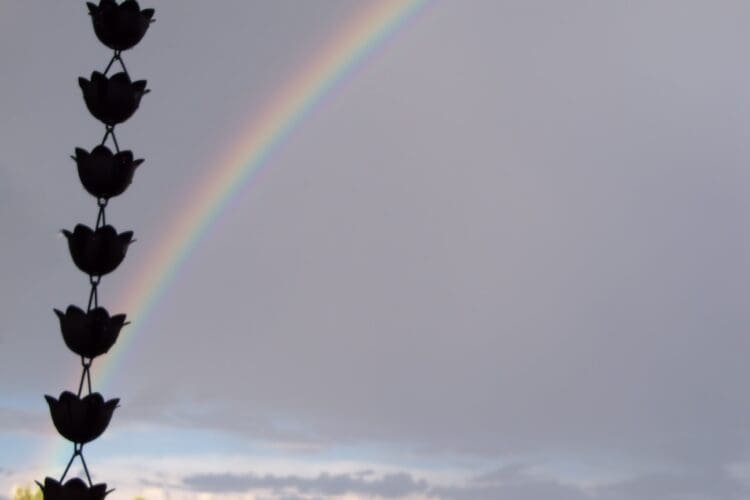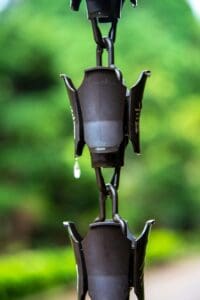What Are Rain Chains?
Gutters | July 8, 2024
You’ve heard of downspouts, but have you heard of rain chains?
Rain chains are an alternative to traditional downspouts. They are both beautiful and functional, which is why they’ve been gaining popularity in the past years. Rain chains look like long chains of decorative metal that direct rainwater into a specific place, helping prevent water damage and a build-up of rainwater.
Read on to learn more about rain chains, how they compare to downspouts, and how they can help manage the flow of rainwater.
The Science Behind Rain Chains
The way rain chains work is simple. By using surface tension, they allow any water collected in gutters to flow down the length of the chain, which then forms a steady flow of rainwater down to the ground.
Because it is a long chain, the water naturally slows down as it passes along the rain chain. There is less force when it finally reaches the ground, which means less soil loss and erosion.
How Do Rain Chains Work?
Rain chains work similarly to downspouts. They connect to your gutters and the water then follows the path of least resistance down the chain.
Installing them is also pretty straightforward—you can use a gutter clip to attach your chain to the gutter. These clips typically come with the rain chain. Some people also prefer to anchor the rain chain to the floor. That way it is secured while pouring the water directly where you want it to.
Others will follow the Japanese tradition, which is when you place the rain chain above a drain, and then cover that drain with pebbles and stones.
Rain Chain Designs and Materials
Rain chains come in a range of styles. You’re sure to find one that fits the style of your home, even if it does take a bit of looking. 
Rain chains are comprised of a series of decorative cups or shapes chained together. These cups and shapes can be made up of different kinds of materials, including:
- Copper
- Aluminum
- Brass
Your rain chain can include links and loops only, cups, or other shapes. There are also rain chains that feature decorative and themed elements.
How To Install a Rain Chain
Good news—installing a rain chain is easy. You can probably do it yourself, but there is also the option to consult with a professional to ensure you place the rain chain in a place of maximum performance.
Installing a rain chain typically involves hanging the rain chain from the gutter, and then securing the bottom.
DIY vs. Professional Installation
Most rain chains come with installation kits for you to assemble yourself. As long as you are relatively familiar with the way gutters work, and you have an idea of where you want the rainwater runoff to go, then you can go ahead and install your rain chain. Some homeowners choose to put the rain chain directly above specific planters, barrels, drains, or containers.
If you choose professional rain chain installation, that will ensure you get the best results from your rain chain. Placement is essential to make sure the water coming from your roof doesn’t pool around your home’s foundation, which can then lead to water damage and structural damage.
Pros of Rain Chains
- They are decorative and visually appealing. You can choose a rain chain that matches perfectly with your home’s aesthetic. Opt for beautiful copper bells or elegant brass cups—the choice is yours.
- They work just as good, if not better, than downspouts. Rain chains serve the same purpose as downspouts, but because the water gently flows down a rain chain, it can help minimize erosion. Downspouts typically don’t do this.
- They facilitate rainwater harvesting. Because you can place a rain chain anywhere, you can easily direct rainwater to wherever you want it to go.
- They have a simple installation process. Oftentimes, you just need to clip the chain to the gutter, and you’re ready to go.
Cons of Rain Chains
- They have a limited water flow capacity. In very heavy precipitation, rain chains may have a hard time gently directing the flow of water.
- If improperly placed, they may cause splashing. This could lead to damage to surrounding soil or plants.
- They are more susceptible to harsh weather conditions. Rain chains can break in extreme wind, and they won’t work as well in heavy precipitation.
Comparing Rain Chains and Downspouts
On one hand, rain chains are often prettier than downspouts and they help prevent soil erosion. However, downspouts do the same thing rain chains do, with minimal splashback in heavy rain. Downspouts are also sturdier than rain chains—they won’t freeze or break in the wind.
Manage the Flow of Rain Water and Precipitation With Gutterman
Rain chains can be an attractive addition to your home’s exterior. But they only work best when used with other draining systems, like French drains or rain barrels. Additionally, they must be perfectly placed with your gutters to best let the water drain out.
Work with a professional gutter company, like Gutterman, to ensure the best rain chain installation that works with your gutter system. We also offer gutter installation.


